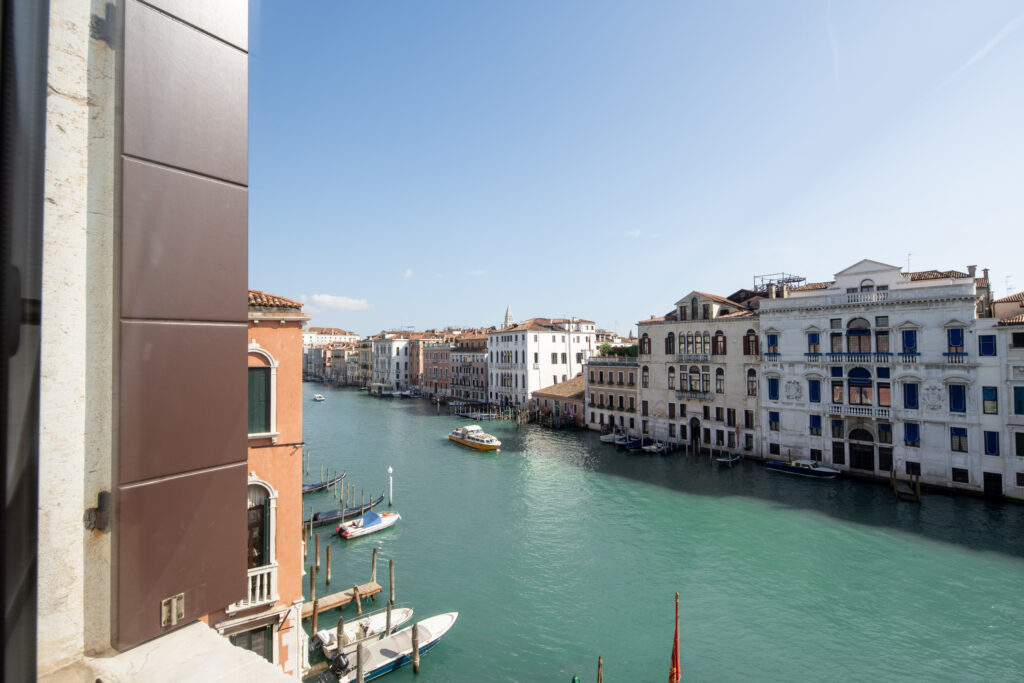Venice has more than four hundred bridges today, but it wasn’t always this way. For centuries, long before the arrival of vaporetti and even before the construction of the current bridges over the Grand Canal, the only way to cross the city was to step into a boat. From this simple gesture came one of the most poetic and intelligent services Venice ever created: the “traghetti da parada“.
There used to be twelve of them, placed strategically along the Grand Canal, allowing people to move quickly from one bank to the other without long detours through calli and small bridges. They were part of daily life, almost invisible, woven into the city’s choreography like the water that sustains it. Today only a handful survive, but their charm remains untouched.
Imagining Venice as it once was means rediscovering a form of mobility that belongs to its deepest identity. When bridges were few and the Grand Canal acted as a natural boundary, the traghetto was simply normal life: you walked down to the bank, called the boatman, stepped aboard, and in a few seconds you were on the other side, ready to continue your day in another sestiere.
Restoring, preserving or even just telling the story of these crossings means bringing back a different Venice, one made of swift passages, unexpected perspectives, and new ways of moving through the city without following the usual routes.
Where it all began
It was the early Venetian boatmen who, without realizing it, invented the modern idea of urban public transport.
The traghetto, this was the name of the boat assigned to carry people and goods along a designated route, was regulated by a surprisingly advanced system. It was run by the Fraglie, professional guilds organized with strict rules and detailed statutes, the Mariegole, which laid out norms, tariffs and responsibilities.
Traghetti were divided into two main categories:
• “traghetti de dentro”, operating within the city, split into traghetti da parada (simple crossings) and traghetti da nolo (longer transfers);
• “traghetti de fora”, connecting Venice to the mainland and transporting both people and goods.
At the fall of the Republic in 1797, there was still a dense network of crossing points, each with its own history and its own group of boatmen.
The “barchéta”, not the gondola
Visitors may think they see gondolas everywhere, but the traghetto da parada is not a gondola: not in gesture, function, or shape.
The traghetto uses a “barchéta“, a sturdier, wider, more stable rowing boat with deeper roots in Venice’s working tradition. It was once used even for transporting the sick, essentially a rowing ambulance. When emergency services were handed over to motorboats, a few barchéte remained in use, and in 1953 they officially replaced gondolas in providing public traghetto service.
A barchéta can carry up to fourteen passengers, compared to the six of a traditional gondola, and is rowed standing up, without frills, just the natural ease of those who treat water as a street.
A gondola as Venetians really use it
The traghetto da parada offers one of the most genuinely Venetian experiences. There are no stereotypes, no serenades, no souvenir prices.
It costs very little, €2 for visitors, €0.70 for residents, and exists primarily for those who live the city every day.
For many Venetians, the traghetto has been their first real contact with navigating the city: a daily, almost automatic gesture that often comes years before ever stepping into a gondola “for a tour.” You cross the Grand Canal trusting your balance, the boatman’s movement, and the rhythm of the water.
The journey lasts only a few minutes, but it captures something rare: a Venice you don’t observe, you simply live.
Where the traghetti still run today
Today, traghetti da parada remain at strategic points along the Grand Canal: San Tomà, Santa Sofia, Santa Maria del Giglio, Riva del Carbon, Punta della Dogana.
The busiest is San Tomà, which cuts in half the distance between San Marco and Piazzale Roma, an invaluable shortcut for anyone hoping to avoid the crowds on the Rialto Bridge.
But there is an increasingly noticeable issue: the queues of tourists, often very long, risk distorting a tradition meant for Venetians. Raising awareness among visitors, making it clear that this is not a tourist attraction but a form of public transport, is essential to preserve the delicate balance between local life and hospitality.
Ca’ Marcello: a front-row view of the traghetto’s quiet ballet
One of the most captivating spots along this quiet ebb and flow is the traghetto at San Tomà.
Just beside it stands Ca’ Marcello, the historic palazzo where The Red House Company hosts three of its apartments.
Its windows open onto the uninterrupted movement of the “barchéta”: a slow, almost ritual flow that marks the day like a steady heartbeat. Watching the traghetto depart, return, fill and empty becomes hypnotic, one of the most intimate and authentic sights Venice can offer.
It is a rare privilege to watch the traghetto move in its gentle rhythm across the canal, a gesture rooted in Venetian daily life, even if, today, it is often visitors who experience it most.




